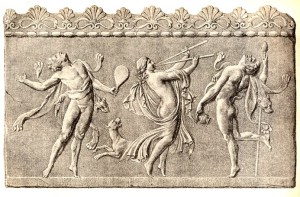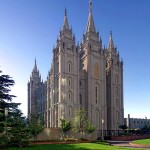This is a variant of a quote attributed to Emma Goldman (“If I can’t dance, I don’t want your revolution!”), and it is also a variant of what my 9 year-old daughter told my wife this past Sunday. My daughter had just gotten chewed out by my wife for taking so long to find her scriptures (Bible and Book of Mormon) and making the family late to church. My wife commented that, if my daughter would read her scriptures daily “like she is supposed to”, she would not have difficulty finding them. My daughter responded that this was why she didn’t want to be Christian: there were too many things Christians have to do, whereas Pagans just dance.

I am a bit concerned. To a certain extent, I think my daughter has the right idea. Joy and the expression of joy through dancing and other celebratory activities are at the heart of Neopagan practice. R. Marett’s quote about “primitive religion” has been applied to Neo paganismwith good reason: it “is not so much something thought out as danced out.” And Robert Graves expressed well the Pagan ethos when he wrote:
Religious morals, in a healthy society, are best enforced by drums, moonlight, fasting [I think he meant “feasting”], dancing, masks, flowers, divine possession.
And yet, this emphasis on joy and celebration can create the perception that Neopaganism is not a demanding religion. I suppose that, in some of its forms, it really is not a demanding religion. But as I see it, Paganism can be as rigorous or more than Mormonism. The difference is the locus of the authority prescribing religious duties. Instead of religious duties being prescribed by an external religious authority, like in Mormonism, one’s religious responsibilities have to be articulated by every individual Neopagan for themselves.
Just a week or so ago, while I was visiting the Mormon church, I listened to a “talk” (sermon by a lay member) which essentially was a laundry list of all the things Mormons are expected to do:
Pray in the morning and evening
Pray over every meal
Read scripture for 30 minutes a day
Weekly church attendance — services consist of 3 one-hour blocks
Fulfilling one’s “calling”, such as teaching weekly at church meetings or administrative responsibilities, which often involve additional weekly or monthly organizational meetings
Weekly “Family Home Evening” (usually on Monday night), which involves prayer, a religious lesson, and a family activity
Attend weekly mid-week church activities for youth (usually on Wednesday evening) and monthly activities for adults
Visit other members monthly (“Home Teaching” by men to around three member families and “Visiting Teaching” by women to around three other women)
Fasting (abstaining from 2 meals) on a monthly basis with a specific request to God in mind
At least annual attendance at a Mormon temple (where vicarious salvific ordinances for the deceased are performed) — this often involves driving not insignificant distances to the nearest temple if you live outside of “Mormondom” or not in proximity to a major metropolitan area
Missionary work among one’s neighbors
Family genealogy
That’s some to do list. And this is just what I can think of off the top of my head after being out of the LDS Church for 10 years — my wife could probably add some more.
Compare that with what Neopagans have to do … well, I can’t think of anything actually. Probably most consider the 8 seasonal celebrations to be semi-compulsory. Fewer would consider any form of daily or weekly devotional to be necessary. It is for this reason that I am grateful to Neopagans like T. Thorn Coyle who strongly advocate regular spiritual practice. She writes:
“Effective people all have some daily touchstone. If your life is not as you wish, or you are foundering spiritually, running from epiphany to being stuck, it is likely that daily practice is missing from your life.”
It’s often been said that Neopaganism is not a religion that requires orthodoxy, but rather orthopraxy. But I couldn’t imagine anything being less true of Neopaganism. Sure, Neopagans do not share any dogma, but neither do they share much praxis either.
Personally, I am grateful for this. I love creating my own rituals and tailoring my spiritual practice for my needs. The process of creating rituals is itself a spiritual practice for me. I see it as an art form, one which gives concrete expression to abstract theological concepts. And the absence of any religious authority works for me. I am one of those people who needs to feel the internal motivation before I do anything. My wife is the opposite. She is a “do it until your feel it” type of person. That’s part of the reason why I am not suited to Mormonism and she is. That’s not to say that it is easy to be the master of one’s own spiritual practice. I still struggle with regular spiritual practice and I have posted about this before.
But getting back to my daughter, it seems that I have succeeded in communicating the celebratory and individualistic aspects of Neopaganism to her, without also communicating the need for reverence and responsibility. The Wiccan Charge of the Goddess reads:
“Let there be beauty and strength, power and compassion, honor and humility, mirth and reverence within you.”
A few years ago, I came across this list of values published by the “Sacred Order of Living Paganism” (now the Shanddite Order):
Reverence
Respect
Reason
Responsibility
Revelry
It seems my daughter has picked up on the fifth “R”, Revelry, but not so much the fourth: “Responsibility”. I realize now that I have completely failed to communicate to my kids that Paganism is about responsibility as much as it is about revelry. And not just responsibility to the planet and to other people, but also responsibility to themselves, for their own spiritual development. And this requires discipline and daily, weekly, and monthly spiritual practice.
In addition to the eight annual celebrations with my family, I have a morning devotional and an evening devotional. I also have a prayer/meditation over meals that I am less than regular about. I also have engaged in fasting, though not regularly. I also have been wanting to do weekly libations, with a different prayer/meditation and a different libation/offering for different parts of the year:
Winter Solstice: oil
Mid-Winter: salt water
Spring Equinox: pure water
Mid-Spring: milk
Summer Solstice: honey
Mid-Summer: fruit juice
Autumn Equinox: vinegar
Mid-Autumn: red wine
I also try to meditate silently once a week. Writing this blog is also an important spiritual practice for me. And I haven’t shared much of this with my kids, and I really should.
I seem also have failed to communicate to my children about the importance of the fourth “R”, Reverence, to Neopaganism. (By “reverence” I mean the expression of an attitude of profound respect.) This came up recently at our Midwinter (Imbolc) celebration this year. Of all the rituals I have written for the family, the Midwinter one has the most formalized ritual. And both times we have performed it, this year and last, both of my kids had trouble being reverent during the ritual. Mind you, the ritual is not all serious. We sang and we danced and we joked. But part of the ritual called for reverence, and my kids were seriously lacking in it.
Part of that is because I did not adequately prepare them or communicate my expectations. Part of it is that they are kids. And part of it is that my daughter’s personality is such that, if it’s not fun, she doesn’t see the point. Still, I expected more from both of them, not least because of their participation in the Mormon church.
Reverence is something that Mormons have down. From a young age, Mormon kids are trained at least in the mechanics of reverence: folded arms, closed lips, bowed heads. Mormons keep their children through their main Sunday service — no separating the children from the adults until Sunday School — so they have to learn to be reverent, or at least quiet. And by the time they are adults and attend Mormon temple ceremonies, they are prepared for an experience of profound reverence there. My son is now at the age that he helps administer the Eucharist (Mormons call it the “Sacrament”). I have seen him do it with a great deal of reverence.
And yet, I could not get any reverence out of him during our Midwinter ritual. He yawned every time he was asked to read a part and could not hold still and remain attentive during the most serious part of the ritual. When it came to dancing though, he shed any teenage self-consciousness, and jumped right in with my daughter. I don’t want to discourage what enthusiasm my kids have shown for Neopaganism, but neither do I want them to have the misapprehension that my religion is less “serious” than Mormonism. I think teaching them about the five “R’s” is a good idea.















